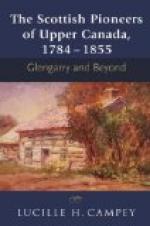On the 11th of January, as some of Hearne’s companions were hunting, they saw the track of a strange snowshoe, which they followed, and at a considerable distance came to a little hut, where they discovered a young woman sitting alone. As they found that she understood their language, they brought her with them to the tents. On examination she proved to be one of the Western Dog-rib Indians, who had been taken prisoner by the Athapaska Indians in the summer of 1770. From these, in the following summer, she had escaped, with the intention of returning to her own country, but the distance being so great, and the way being unknown to her, she forgot the track, so she built the hut in which they found her, to protect her from the weather during the winter, and here she had resided from the first setting in of the cold weather. For seven months she had seen no human face. During all this time she had supported herself in comparative comfort by snaring grouse, rabbits, and squirrels; she had also killed two or three beaver, and some porcupines. That she did not seem to have been in want was evident, as she had a small stock of provisions by her when she was discovered, and was in good health and condition; and Hearne thought her “one of the finest women”, of the real Indian type, that he had seen in any part of North America.
“The methods practised by this poor creature to procure a livelihood were truly admirable, and are great proofs that necessity is the real mother of invention. When the few deer sinews that she had an opportunity of taking with her were all expended in making snares and sewing her clothing, she had nothing to supply their place but the sinews of the rabbits’ [he means hares’] legs and feet; these she twisted together for that purpose with great dexterity and success. The rabbits, &c, which she caught in those snares, not only furnished her with a comfortable subsistence, but of the skins she made a suit of neat and warm clothing for the winter. It is scarcely possible to conceive that a person in her forlorn situation could be so composed as to be capable of contriving or executing anything that was not absolutely necessary to her existence; but there were sufficient proofs that she had extended her care much farther, as all her clothing, beside being calculated for real service, showed great taste and exhibited no little variety of ornament. The materials, though rude, were very curiously wrought and so judiciously placed as to make the whole of her garb have a very pleasing, though rather romantic, appearance.




